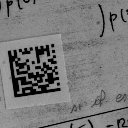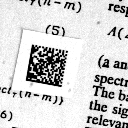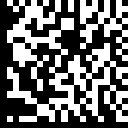Image processing
French
version
Papers and thesis about image processing research.
Conception of 2D-symbolic codes reader by image analysis.
PhD thesis: overview
Presentation
Title:
Étude sur la lecture automatique de codes bi-dimensionnels par traitement d'image (A study on automatic reading of bi-dimensional
symbolic codes by image processing).
Specialization: Image processing (Traitement du signal)
Subject: conception of 2D-symbolic codes reader by image analysis.
Keywords:
symbolic codes,
edge search,
image processing,
ligne search,
texture segmentation,
Oral presentation did occur on 17 December 1997 at ENSEEIHT.
Summary
 Data Matrix is a new kind of bi-dimensional symbolic code issued
from the classic bar codes symbols. It uses the 2 directions of
the plane, like a chess pad where each cell represents one binary
digit. The point of the study is to design reading algorithms
for these codes by image processing.
Data Matrix is a new kind of bi-dimensional symbolic code issued
from the classic bar codes symbols. It uses the 2 directions of
the plane, like a chess pad where each cell represents one binary
digit. The point of the study is to design reading algorithms
for these codes by image processing.
The main constraints are:
- The reading must be insensitive to the distortion when the
symbol does not perfectly face the camera. This requires robust
detection functions.
- The reading must be performed in a very short time, short
enough to be considered as instantaneous by a human operator.
This requires fast and simple algorithms.

Many papers have been reviewed, aiming to find and understand
the existing methods for these kind of problem.
Comparison of the methods led us to conclude on a exhaustive and
coherent method based on edge detection by laplacian detectors,
edge localisation by gradient operator, detection validation by texture analysis.
The developed method is:
- Edge detection and aggregation in chains and lines.
- Search for couple of lines having the Data Matrix L
shape pattern using geometric properties and local texture properties.
- Analysis of the inside near border of the symbol to figure
the number of cells in the matrix.
- Sampling of the symbol according to the number and position
of the peripheral cells.
The method has been implemented in an image processing software.
Many tests have been performed to validate and figure the limits
of the method against cell size, contrast, heterogeneous background
level, optical and projective distortions, focalisation. A detailed
study on time processing of the different steps is presented.
|
Symbol image
|
Read symbol
|
Symbol content
|

|
 |
163 81 92 94 75
34 90 205 204 128 231 54 193 247 165 157 220 125 226 133 106 123 105 149
219 21 27 149 171 166 71 118 43 67 246 87 4 8 170 249 73 191 21 185 26 219
0 |
Oral presentation
report
The oral presentation report is only (available in French...)
Credits
 This research has been conducted in group
Signaux Images & Communications
(
This research has been conducted in group
Signaux Images & Communications
( ) du Laboratoire d'Électronique de l'ENSEEIHT (
) du Laboratoire d'Électronique de l'ENSEEIHT ( LEN7
LEN7  ) - INPT.
) - INPT.
The thesis has been supervised by Pr. Michel Cattoen, professor at ENSEEIHT
and founded by  Intermec - Technologies Corporation (
Intermec - Technologies Corporation ( ), part of the group Unova.
), part of the group Unova.
Jury: Dominique Barba - Rapporteur, Jean Bajon - Examinateur, Maurice Briot - Rapporteur, Philippe Marthon - Examinateur, Michel Cattoën - Directeur de thèse, Jean-Louis Massieu - Examinateur.
SIC - LEN7 - ENSEEIHT
2 rue Charles Camichel
B.P. 7122
31071 Toulouse CEDEX 7 (France)
Tel.: +33 (0) 5 61 58 83 20
Contact : Pr Cattoën (cattoen@len7.enseeiht.fr)
http://www.dunwich.org/baptiste/sic/indexe.html
Download
The report is in French.
Online version : here.
Publication: Edge and line detection in low level analysis
This work is part of a study on 2D-symbolic codes reader by image
analysis. You may
get the full length version.
Reference:
Baptiste Marcel( )
and
Michel Cattoen, « Edge and line
detection in low level analysis », 3rd Workshop
on Electronic Control and Measuring System, Université Paul Sabatier, Toulouse, 2-3 June 1997,
p. 89-97.
)
and
Michel Cattoen, « Edge and line
detection in low level analysis », 3rd Workshop
on Electronic Control and Measuring System, Université Paul Sabatier, Toulouse, 2-3 June 1997,
p. 89-97.
Abstract:
« Edge detection and linear feature extraction are important and
critical
components in an image understanding system, as the result of the
extraction
will be the basis of the high level processes.
In this paper, we have described a new straight line detection
algorithm,
using traditional derivative-based edge operators, which works
without
internal thresholding, and thus delay detection decisions in the main
processes
of the image analysis system rather than in the low-level line
detection
processes.
The algorithm includes two derivative processing by well-known
laplacian
and gradient filters to determine edge location and orientation, then
extract
the lines by three steps which are: edge linking, edge straightening
and
line correction. The usual smoothing and thinning steps are not
processed
as they are implicit in the algorithm by the choice of the derivative
method.
The algorithm is executed in 5 phases. In phase 1, thin edges are
detected on zero crossings of the laplacian filter's response. The
size
of the laplacian filter determines the bandwidth of the implicit
smoothing
in the filter process. In phase 2, the orientation of each detected
edge
is computed by 2 gradient filters. In phase 3, the edges are linked
according
to the direction of their gradient vector, and the short chains of
pixel,
i.e. smaller then 3 or 4 pixels, are eliminated. This elimination
removes
from the response all the noise which had been detected by the first
phase
and thus eliminate the spurious edges, keeping the low contrast
lines.
In phase 4, the chains are broken to obtain straight lines. In phase
5,
lines are corrected to recover isolated missing edge element and to
join
lines on corner if necessary.
The algorithm works well for detection and localization of
Data-Matrix symbols (kind of 2 dimensionnal bar-codes) in images with
bimodal intensity distribution.
Several important parts of this method are based on linear filters.
Thes computations which usually occur in low-level layers of the
system should be able to process fast on hardware embodiment,
although this has not yet be verified. »
Key words:
- edge detection;
- line detection;
- image analysis;
- laplacian filtering.
Online version : here.
Publication: Détection de contours et de lignes dans les procédures
de bas-niveau
This paper is the French version of the article above.
Réference :
Baptiste
Marcel
et
Michel
Cattoen, « Détection de contours et de lignes dans les procédures
de bas-niveau », 3rd Workshop
on Electronic Control and Measuring System, 2-3 juin 1997, pp. 89-97.
Online version : here.
Publication: Calcul de translation et rotation par la transformée de
Fourier
« Estimation of Translation and Rotation by Fourier Transform » .
This work is the result of a six mounths work on LAAS (CNRS) about image
translation and rotation, and is part of a robotic project for
autonomous robots. Autonomous robots are up to date, with success of
Mars Pathfinder
mission.
Reference:
Baptiste Marcel ( ), Maurice Briot and Rafael Murrieta,
« Calcul de translation et rotation par la transformée de Fourier »,
Traitement du signal
(
), Maurice Briot and Rafael Murrieta,
« Calcul de translation et rotation par la transformée de Fourier »,
Traitement du signal
( ), Vol. 14, n°2, mars 1997,
p. 135-149.
), Vol. 14, n°2, mars 1997,
p. 135-149.
Abstract:
« In the research area of vision-aided motion sensors,
the rotation parameters can be computed from the motion in the
picture. The properties of translation and rotation in the frequency
domain of the Fourier transform are used here.
This study is restricted to rigid-body transformations,
but other application domains, such as matching of rigidly misaligned
images, also exist. »
Key words:
- Mobile robotics;
- Image processing;
- Image rotation and translation compensation;
- Fourier transform.
Online version : here.
Publication: Mise en œuvre de méthodes de recherche de lignes et d'analyse de textures pour la détection et la localisation de symboles bi-dimensionnels
This paper is a summary of the research which underwent the thesis mentioned above.
References: 11è congrès RFIA (Reconnaissance des Formes et Intelligence Artificielle) in Clermont-Ferrand 20-22 January 1998 (AFCET, AFIA, Université Blaise Pascal de Clermont-Ferrand).
Online version : here.
Publication: Aspectos dinámicos de la visión: Seguimiento de objetos no rígidos y estimación de la rotación de una cámara (co-author)
Authors : Rafael Murrieta Cid, Baptiste Marcel, Héctor H. Gonzáles Baños.
Language : castellano.
Published : Journal "Computación y Sistemas", Vol. 1 No. 4, pages 201-212, avril 1998.
This paper continues where the previous left off (Calcul de translation et rotation par la transformée de Fourier) and explores the segmentation issues.
Online version : here.
Code
I do not believe this code is still usable in an industrial context because it's quite old. However...
For those who whish to have a look, be informed that the application had a temporary work name: Iris.
It started as a C application under M$-DOS, then in the middle, we migrated to C++ under M$*Windows.
We had a framework which was able to acquire snapshots from a camera,
then the framework was calling functions to process whatever.
In the soup that I leave online, you will have to thread your way around.
- File : thesis_code_A005-accpp+awbc45.zip (17.8 MB)
- Auteur : ENSEEIHT+Baptiste Marcel
- Ayant-droit : ENSEEIHT+Baptiste Marcel+UBI/Intermec-STC
- Licence : © tous droits réservés, toléré de circuler pour des raisons pédagogique, interdit d'utiliser à des fins d'exécution
- Source : http://www.dunwich.org/baptiste/sic/indexe.html#thesis
Abreviations and links
- CNRS: Centre
National de Recherche Scientifique.
- ENSEEIHT:
École
Nationale Supérieure d'Électronique,
Électrotechnique
et Hydraulique de Toulouse.
- INPT
(
 ) :
Institut National Polytechnique de Toulouse.
) :
Institut National Polytechnique de Toulouse.
- INSA (
 ) :
Institut National des Sciences Appliquées.
) :
Institut National des Sciences Appliquées.
- LAAS: Laboratoire
d'Analyse
et d'Architecture des Systèmes.
- LEN7
(
 ): Laboratoire d'Électronique de l'ENSEEIHT.
): Laboratoire d'Électronique de l'ENSEEIHT.
- SIC
(
 ): Signaux, Images et Communication.
): Signaux, Images et Communication.
Scholar background
Engineer in computer science and doctor in electronics.
I graduated engineer at INSA ( ),
in Toulouse, and I made my first research study (D.E.A.) at LAAS
- CNRS (Toulouse).
),
in Toulouse, and I made my first research study (D.E.A.) at LAAS
- CNRS (Toulouse).
I made my PhD thesis at ENSEEIHT
(École Nationale Supérieure d'Électronique,
Électrotechnique
et Hydraulique de Toulouse), within the group S.I.C.
( )
(Signaux, Images et Communication), part of LEN7 (
)
(Signaux, Images et Communication), part of LEN7 ( )
(Laboratoire d'Électronique de l'ENSEEIHT), in Toulouse
(France), in the field of image analysis.
)
(Laboratoire d'Électronique de l'ENSEEIHT), in Toulouse
(France), in the field of image analysis.
The rest is documented in my LinkedIn profile.
File created July 1996, last update
21/02/2011
by by Baptiste MARCEL (see page Contact),
located in Asnières-sur-Seine (France).
If you enjoyed this page, please do not forget to visit my homepage
and to request more information about
this site.



 This research has been conducted in group
Signaux Images & Communications
(
This research has been conducted in group
Signaux Images & Communications
( LEN7
LEN7  Intermec - Technologies Corporation (
Intermec - Technologies Corporation (






![]() ),
in Toulouse, and I made my first research study (D.E.A.) at LAAS
- CNRS (Toulouse).
),
in Toulouse, and I made my first research study (D.E.A.) at LAAS
- CNRS (Toulouse). ![]() )
(Signaux, Images et Communication), part of LEN7 (
)
(Signaux, Images et Communication), part of LEN7 (![]() )
(Laboratoire d'Électronique de l'ENSEEIHT), in Toulouse
(France), in the field of image analysis.
)
(Laboratoire d'Électronique de l'ENSEEIHT), in Toulouse
(France), in the field of image analysis.